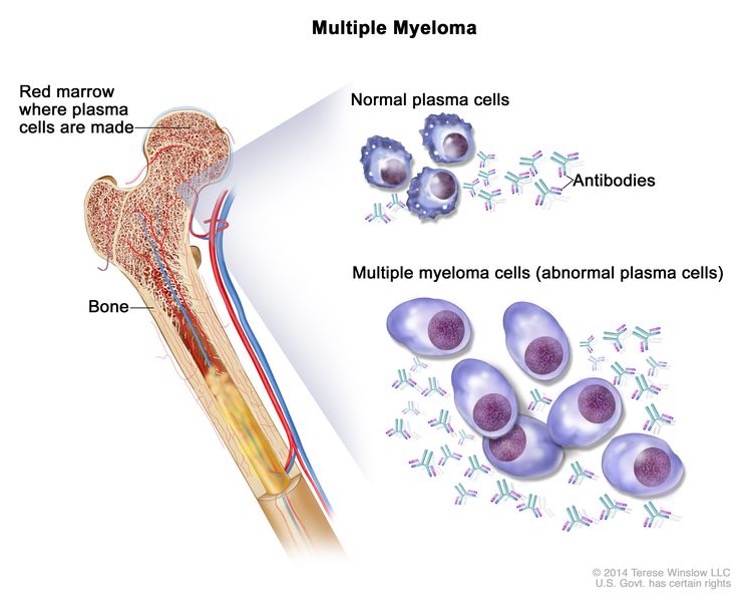- High Risk Smoldering Multiple Myeloma
- What Tests Will I Need And Why?
High Risk Smoldering Multiple Myeloma
Smoldering Multiple Myeloma High-Risk diagnosis means that multiple myeloma is present but not yet causing symptoms or organ damage, though it is at a higher risk of progressing to active multiple myeloma.
About 50% of people diagnosed will develop multiple myeloma, a rare blood cancer where plasma cells found in the bones marrow, grow abnormally. Unlike active multiple myeloma, SMM does not cause symptoms, often referred to as asymptomatic.
Low-risk SMM is typically monitored without treatment to avoid unnecessary side effects.
High-risk SMM requires closer attention and, in some cases, early intervention to prevent complications associated with active multiple myeloma.
About 10% of people with SMM progress to active multiple myeloma each year. SMM is categorized into low risk and high risk; those with high risk SMM are more likely to progress to active multiple myeloma sooner.
Helpful terms to know:
Plasma cells: These are a type of white blood cell that makes antibodies, which are like tiny soldiers in your body that fight germs. In SMM, some plasma cells become abnormal and start multiplying too much.
High-risk: This means there are more abnormal cells or proteins compared to lower-risk cases,
Smoldering: This word means that the condition is “quiet” or “simmering.”

Cancer.gov
Overview
A Multiple Myeloma diagnosis and risk level is determined using a variety of tests to see how advanced the condition is and whether it’s likely to progress. Here’s an overview of the main tests:
Blood Tests:
Complete Blood Count (CBC) checks for low levels of red blood cells, white blood cells, or platelets, which can indicate bone marrow issues.
Serum Protein Electrophoresis (SPEP) measures the level of abnormal proteins being produced by cancerous plasma cells.
Calcium Levels to determine if bone damage has been caused by multiple myeloma.
Creatinine Levels assess kidney function, which can be affected by multiple myeloma.
Urine Tests: find any abnormal proteins which are produced by abnormal plasma cells.
Bone Marrow Biopsy: primarily used to check the percentage of abnormal plasma cells verses normal plasma cells and to perform genetic testing to look for genetic abnormalities that may be linked to higher risk.
Imaging Tests: An X-ray, MRI and Pet Scan look for any bone damage or active disease.
High Risk Smoldering Multiple Myeloma test results include:
- Bone marrow plasma cells are greater than 20%.
- M-protein level is greater than 2g/dL.
- Serum FLC (free light chain) ratio is greater than 20.
These factors indicate a higher likelihood of the disease advancing to active multiple myeloma.
Re-read this summary as needed and then tap, “Compare My Treatment Options Now“. Our unique Comparison Page will help you understand your FDA-approved treatment options where and how each is given and what side-effects you may experience.
Recommended Multiple Myeloma Cancer Videos

What is Smoldering Myeloma?
What occurs during smoldering myeloma?

Multiple Myeloma: Symptoms, Treatment, and Patient Care
Multiple myeloma is a cancer that forms in a type of white blood cell called a plasma cell.

What Causes Multiple Myeloma?
Learn how an abnormal growth of plasma cells can lead to the formation of multiple myeloma

How is Multiple Myeloma Diagnosed and What Testing is Necessary After?
What testing is involved in multiple myeloma diagnosis and treatment?

What Are the Beginning Stages of Multiple Myeloma (MM)?
What happens in early stages of multiple myeloma?

How is Multiple Myeloma Staged?
Watch as expert Dr. Abdullah Khan explains staging and its use, and myeloma patient and Empowerment Lead Lisa Hatfield shares how the use of staging and its factors have evolved over time.
Commonly Searched Questions
Smoldering Multiple Myeloma Recurrence Rate
Cancer.org
Smoldering Multiple Myeloma Prevention
Cancer.org
Smoldering Multiple Myeloma Definition
Cancer.org
Smoldering Multiple Myeloma Symptoms
Cancer.org
Smoldering Multiple Myeloma Treatment
Cancer.org
Smoldering Multiple Myeloma Survival Rate
Cancer.org













